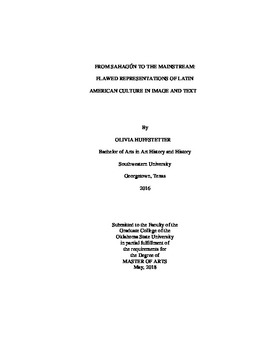| dc.contributor.advisor | Gonzalez, Cristina Cruz | |
| dc.contributor.author | Huffstetter, Olivia | |
| dc.date.accessioned | 2019-03-25T21:41:15Z | |
| dc.date.available | 2019-03-25T21:41:15Z | |
| dc.date.issued | 2018-05-01 | |
| dc.identifier.uri | https://hdl.handle.net/11244/317752 | |
| dc.description.abstract | Early European travel literature was a prominent source from which information about the New World was presented to a general audience. Geographic regions situated within what is now referred to as Latin America were particularly visible in these accounts. Information regarding the religious customs and styles of dress associated with the indigenous peoples who inhabited these lands were especially curious points of interest to the European readers who were attempting to understand the lifestyles of these so-called "savages." These reports, no matter their sources, always claimed to be true and accurate descriptions of what they were documenting. Despite these claims, it is clear that the dominant Western/Christian perspective from which these sources were derived established an extremely visible veil of bias. As a result, the texts and images documenting these accounts display highly flawed and misinformed representations of indigenous Latin American culture. Although it is now understood that these sources were often greatly exaggerated, the texts and images within them are still widely circulated in present-day museum exhibitions. When positioned in this framework, they are meant to be educational references for the audiences that view them. However, museums often condense the amount of information they provide, causing significant details of historical context to be excluded. | |
| dc.description.abstract | With such considerable omission being common in museum exhibitions, it causes one to question if this practice might be perpetuating the distribution of misleading information. Drawing on this question, I seek, with this research, to investigate how early European representations of Latin American culture in travel literature may be linked to current issues of misrepresentation. Particularly, my research is concerned with finding connections that may be present with these texts and images and the negative aspects of cultural appropriation. Looking specifically at representations of Aztec culture, I consult three texts and their accompanying illustrations from the sixteenth, seventeenth, and eighteenth centuries to analyze their misrepresentational qualities, and how they differed between time periods and regions. Finally, I use this information to analyze museum exhibition practices and how they could be improved when displaying complex historical frameworks like those of indigenous Latin American cultures. | |
| dc.format | application/pdf | |
| dc.language | en_US | |
| dc.rights | Copyright is held by the author who has granted the Oklahoma State University Library the non-exclusive right to share this material in its institutional repository. Contact Digital Library Services at lib-dls@okstate.edu or 405-744-9161 for the permission policy on the use, reproduction or distribution of this material. | |
| dc.title | From Sahagun to the Mainstream: Flawed Representations of Latin American Culture in Image and Text | |
| dc.contributor.committeeMember | Brienen, Rebecca Parker | |
| dc.contributor.committeeMember | Arata, Laura | |
| osu.filename | Huffstetter_okstate_0664M_15631.pdf | |
| osu.accesstype | Open Access | |
| dc.description.department | Art History | |
| dc.type.genre | Thesis | |
| dc.type.material | text | |
